
Traffic is crucial for the success of any website and SEO in particular has a strong influence on it. Consistent and high quality traffic that you don’t have to pay for? Who says no to that?
Between search engine algorithms and excessive industry jargon, it can quickly become difficult to get the whole SEO approach under control. In the following 3 steps we will show you how you can create a solid foundation for your website. Before that, however, we should take a step back.
What is SEO and why is it important to your website?
Search Engine Optimization (SEO) is the process of generating more organic (that is, free, natural) traffic from search engines like Google, Bing, and Yahoo. If you search for something on Google, for example, you will get to the search engine results page or Search Engine Ranking Pages (in short: SERP):
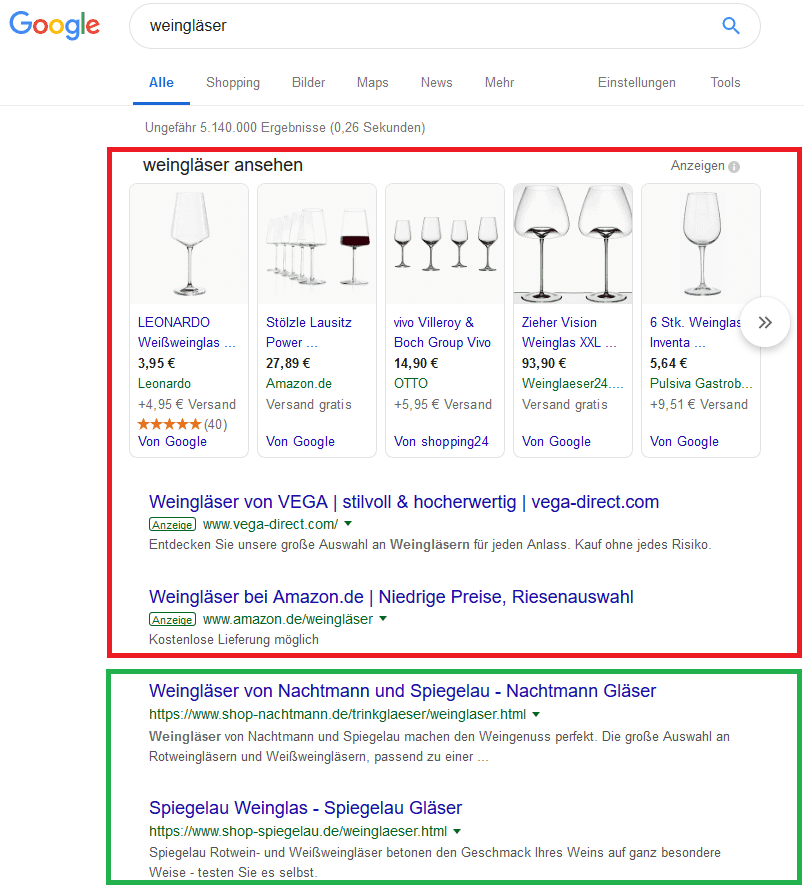
For example, for the search term “wine glasses” you will find these organic results (green) under the paid ads and sponsored Google Shopping results (red) . SEO is all about getting your pages to appear in the top ten organic search results. Of course, there are many more sites to explore, but the higher the number of pages, the less traffic.
Several studies found that only 5% of searchers continued to look on the second page of search engines. On page 3 it is less than 2%. In addition to the pages, the individual items also count. The same study found that the top result on the first page on Google gets an average of 30% of all visits , the second result an average of 18%.
Achieving first place is particularly difficult with strong competitors, so you should initially concentrate on reaching the first page at all, and this is best for several keywords. Often visitors go back to the search results anyway to look elsewhere. At the same time, with several keywords on the first page you have a better chance of being found by more interested parties and you save a lot of time fighting against a strong competitor.
The only question now is, how do you, as a non-professional and without tools, come up with suitable keywords for your own website?
Step 1: Keyword Research
It should come as no surprise that the first step is to identify high quality search terms that your prospects could use when searching. For this, keyword research is very important, which can be done in different ways. It is important to note that online shops with physical products operate differently than websites with information, digital products and services.
Physical products
For example, if you sell products online, the best way to start is with a Google search yourself and pay attention to the Google fill-in function (green):
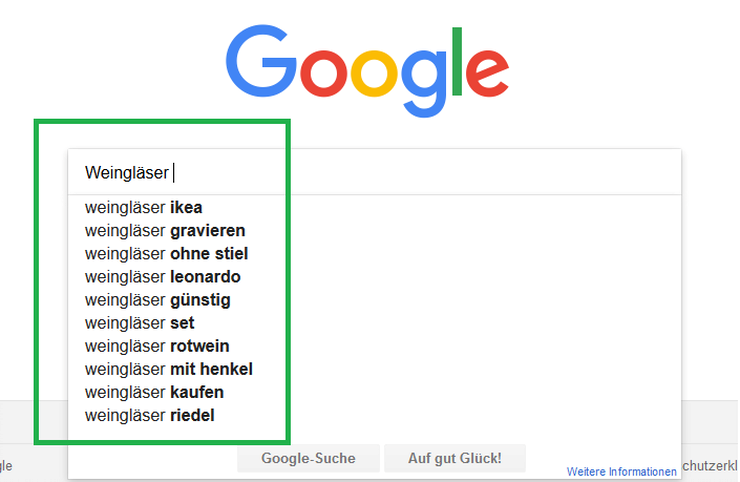
If you then submit your search query (example: “wine glasses”), you can find related search queries at the bottom of the page:

These keywords can be a gold mine for keyword ideas, especially if you already have a few basic keywords in mind and are looking for something even more specific.
When it comes to a physical product, you can do a similar process on Amazon. The great thing about Amazon suggestions is that they are product related, unlike Google which has some information about keyword suggestions.
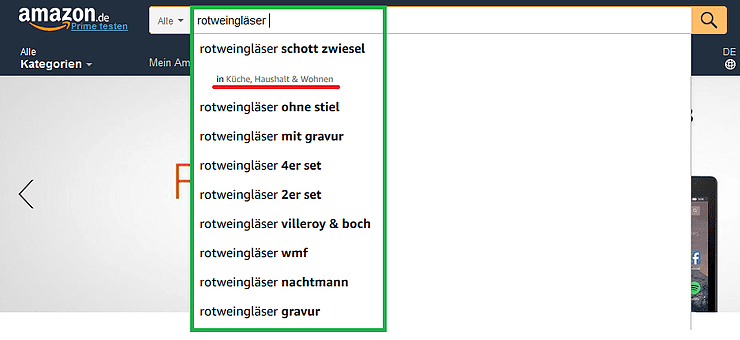
Pay special attention to the keywords that are three to four words long . The longer the keyword, the more specific it is. That means less competition and often higher conversion rates (conversion rate = ratio between views and actions / purchases).
You can automate this process with the help of tools. For example, KTD automates the process for both Google and Amazon. This saves you tons of manual labor, especially if you have a large product catalog.
In addition to Amazon, you can also look at other large sites such as Ebay. First, you should always collect the relevant product subcategories for your keyword and category ideas.
Here we have the categories from Amazon:
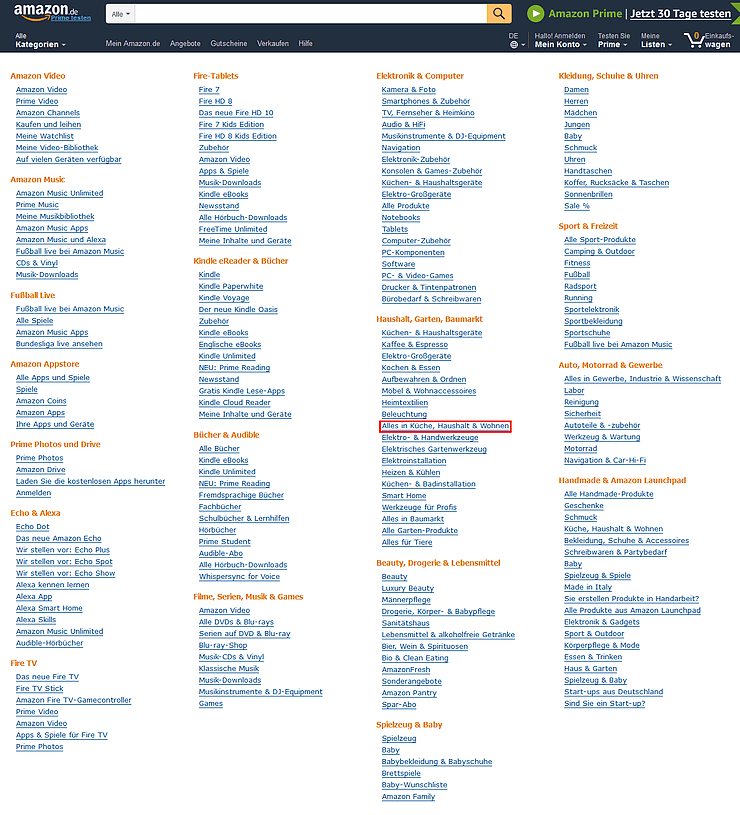 More is probably not possible. Suppose you sell wine glasses. Pick now the category (see above: red) and Choose the most relevant subcategory of (see below: red) . Now you can see how Amazon sorts and organizes their glasses:
More is probably not possible. Suppose you sell wine glasses. Pick now the category (see above: red) and Choose the most relevant subcategory of (see below: red) . Now you can see how Amazon sorts and organizes their glasses:

Combine the new ideas for keywords and product categories. You may also find sub-categories that you can explore and that will give you even more inspiration. Repeat this process for all other large competitors.
Keyword search tool
If you have a budget for an SEO tool , we can recommend SEMrush . Among other things, the tool does the keyword search for you by allowing you to enter the domains of your competitors and get all of their keywords. You can go even further with the tool and, for example, compare your website with others to see for which keywords your competition is listed and you are not. Or you can use the Keyword Magic Tool , which suggests similar keywords from the phrase.
Services and digital products
In contrast to physical products, digital products and services are much more about the content of your texts . So write a little more text about your business so that Google can understand your site and reward you for it accordingly. Of course, you should also find the right keywords here beforehand and include them in your texts. Do not overdo it, however, otherwise your site will be rated as unstructured.
Tip: First write your texts without paying attention to the keywords and then carry out the keyword research. You can then include the most important keywords in your text. This way you avoid your text sounding artificial. If you are using SEMrush , you can use the SEO Writing Assistant to do so.
Optionally, you can get your keywords on Google through suggestions or collect them through Google Trends , Google Adwords and general competitor analyzes. Competitor analysis in this case means: You enter the keywords for which you want to be listed on Google and open the pages of your competitors. Pay attention to the structure and content of the websites.
Choosing the right keywords for your website
Your list of keywords is probably pretty long right now. Now how do you narrow this list down and focus on the keywords that matter most? Start with the basic factors.
1. Volume:
The higher the search volume, the more potential traffic will come to your website. SEMrush can provide you with good data on the search volume, but completely free tools such as the Google Keyword Planner can also be used for this.
Important : Keywords with a high search volume usually mean a lot of competition.
2nd competition:
The lower the competition, the more likely you are to rank well for the keyword. Here too, SEMrush’s Keyword Magic Tool can show you the competition. With a free account you can do 10 free searches per day here. Moz offers an alternative to assess the competition.
Here is an example from Moz:

Page Authority (PA) and Domain Authority (DA) tell you how difficult it would be to rank higher than these organic results. The higher the numbers, the harder it will be to get a good rank for it.
Overall, you should look for keywords with high search volume and low competition.
3. Relevance:
How relevant is your product page or category page to the search term? This is an enormous ranking factor that is often neglected. Stick to keywords that really fit your products. You can’t outsmart Google.
4. The devil is in the details:
You should be specific. Why? Here is an example: You are probably familiar with the many ads like “Earn € 5000 in a day”. Assuming you have a basic interest, would you rather click on this ad or on another one with the text “Get rich”?
You would probably click on the first ad because you can actually do something with it and be addressed more directly. It’s the same with keywords, be detailed.
Step 2: page structure
How your web pages are organized and structured affects your search engine rankings. It also has an impact on the user experience. Basically, you have to make it easy for actual visitors and search engines to find things on your website . Easier said than done. As you add and remove products and categories, your website structure quickly becomes complicated. If you get this point right from the start, you will save yourself a lot of time.
Two important rules:
- Make sure your website structure is simple but also easy to scale as your business grows.
- Every page on your website should be as few clicks away from the homepage as possible.
Simplicity is underestimated. You probably don’t want your visitors to have to rely on the “back” button to find what they’re looking for after going through several circles. And I think you don’t want to have to reorganize and rearrange your entire website structure every time you add a new product category, for example.
Most of your link authority is on your homepage . So it makes sense that the more clicks away from your homepage, the less authority your product page, for example, has.
Step 3: on-page SEO
Now that you’ve done your keyword research and your website structure is ready, we can start optimizing.
Not surprisingly, we’ll start with the basics.
The basics:
If you already have a web host , you probably know that there are some built-in SEO features that you can take advantage of. Some of them even run automatically, like the creation of the sitemap.xml and robots.txt. Other functions require your optimization skills, such as:
- Editing the title tags
- Meta descriptions to insert your keywords
- Alt text for images to insert your keywords
- URL names for blog entries, subpages, products and collections
When optimizing your title tags and descriptions, make sure that they are Google-oriented. Step one, try to get listed on Google on the first page. Step two is to convince searchers that they are actually clicking through your website.
Modifiers like “Discount”, “X% Reduced”, “Free Shipping”, “Wide Range”, etc. can give you a boost. Why? Because Google is suspected of using the clickthrough rate (CTR) as a ranking factor . Search engine optimization alone is not enough, you also have to arouse the interest of searchers.
Choose the right urls
There are a few URL guidelines to follow for optimal ranking:
- Your URL should be easy for real, living people to read and interpret, because accessibility is important to Google.
- Using your keywords in URLs is still highly recommended as they will show up in search results.
- Short URLs are better than long URLs. Try to keep the characters below 50-60.
- Customize your URL and page title as precisely as possible.
- Don’t use stop words like “and”, “of”, “that” and “a”.
- Avoid keyword spam and pointless repetition as this won’t trick Google and will only make your website look unprofessional.
Take advantage of latent semantic indexing (LSI) keywords
LSI keywords are closely related to your main keyword.
You can either find these via a quick Amazon search (or other well-known competitors) or the good ol ‘Google Keyword Planner we talked about above.
On Amazon, you look for your main keyword and then secondary keywords that keep coming up. Let’s take our wine glasses again, for example:
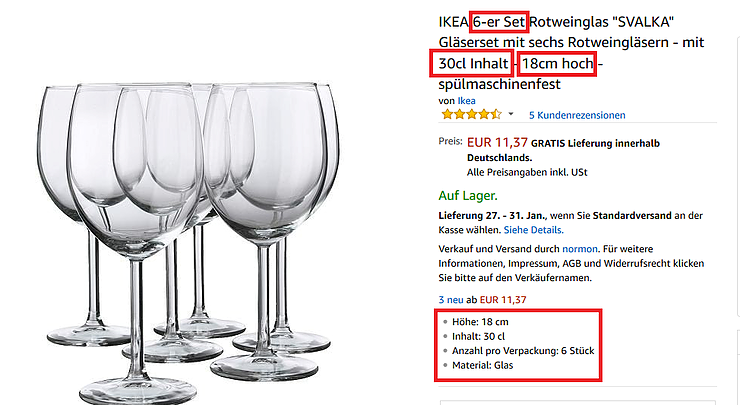
“30cl content” “Set of 6” and “18cm high” all appear multiple times, suggesting that they are strong selling factors and likely common elements of search terms.
You can also run these keywords back through the Google Keyword Planner to get some LSI keyword ideas.
Closing word
There are many more factors and ways to effectively approach SEO. This means technical SEO, link building, content marketing, etc.
The steps outlined above will get you on the right track for now. If you are optimizing your website yourself, you should deal fully with these steps, as your subsequent SEO efforts will build on them. For a more detailed overview and how you can best implement SEO yourself, we recommend that you also take part in our free SEO webinar .
When you’re ready to dive deeper into SEO, you can continue with our follow-up article.






